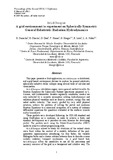Mostrar el registro sencillo del ítem
GridChoque: a grid environment to experiment on spherically symmetric general relativistic radiation hydrodynamics
| dc.rights.license | http://creativecommons.org/licenses/by-nc-sa/3.0/ve/ | |
| dc.contributor.author | Camacho, Reina | |
| dc.contributor.author | Díaz, Gilberto | |
| dc.contributor.author | Hamar, Vanessa | |
| dc.contributor.author | Hoeger, Herbert | |
| dc.contributor.author | León, R. | |
| dc.contributor.author | Núñez, Luis | |
| dc.date.accessioned | 2009-10-20T20:19:20Z | |
| dc.date.available | 2009-10-20T20:19:20Z | |
| dc.date.issued | 2009-10-20T20:19:20Z | |
| dc.identifier.uri | http://www.saber.ula.ve/handle/123456789/29555 | |
| dc.description.abstract | This paper presents a Grid application, GridChoque: a distributed, and a grid based, environment devised to explore the general relativistic spherically radiative stellar collapse using several tools of calculus and visualization. GridChoque calculation engine uses a general method to solve the Einstein Equations for Spherically Radiant spacetimes proposed by L. Herrera, and Collaborators. Besides regularity conditions, models are only restricted by a heuristic assumption relating hydrodynamics and radiation physical variables such as density, pressure, energy flux and radial matter velocity. This ansatz, guided by very solid physical intuition, reduces the problem of solving the partial and nonlinear Einstein Equations to a numerical integration of a system of ordinary differential equations for quantities evaluated at the surfaces (shocks and/or boundaries). These portlets were developed following the JSR-168 standard and using GridSphere as a container, in order to achieve a faster and dynamic development as it provides its own libraries for developing portlet. The portlets work using the Model-View-Controller (MVC) model to achieve a robust programming style. GridChoque allows to study the evolution of the radiant shock wave front within the context of a suitable definition of the postquasistatic approximation introducing the flux factor, the variable Eddington factor and a closure relation between them to describe a more realistic radiation transport mechanism. As a grid based tool, GridChoque offers the possibility to use all the processing and memory resources of the grid in a transparent and intuitive way. The user can provide all the relevant initial values for the physical variables, send the job, monitor the status of the job and visualize the results obtained. It is also possible to follow the evolution of the physical variables (i.e. hydro & radiation pressures, energy & energy flux densities, shell velocities ) through animated variable vs time and variable vs radius graphs. This is why GridChoque can become an useful analysis and educational tool for the relativistic astrophysics community. | es_VE |
| dc.language.iso | es | es_VE |
| dc.rights | info:eu-repo/semantics/openAccess | |
| dc.title | GridChoque: a grid environment to experiment on spherically symmetric general relativistic radiation hydrodynamics | es_VE |
| dc.type | info:eu-repo/semantics/article | |
| dc.description.colacion | 1-8 | es_VE |
| dc.description.email | gilberto@ula.ve | es_VE |
| dc.description.email | vanessa@ula.ve | es_VE |
| dc.description.email | hhoeger@ula.ve | es_VE |
| dc.description.email | nunez@ula.ve | es_VE |
| dc.subject.centroinvestigacion | Centro Nacional de Cálculo Científico (CeCalCULA) | es_VE |
| dc.subject.centroinvestigacion | Centro de Física Fundamental (CFF) | es_VE |
| dc.subject.centroinvestigacion | Centro de Simulación y Modelos (CESIMO) | es_VE |
| dc.subject.departamento | Departamento de Física | es_VE |
| dc.subject.facultad | Facultad de Ciencias | es_VE |
| dc.subject.facultad | Facultad de Ingeniería | es_VE |
| dc.subject.keywords | E-Infrastructure shared between Europe and Latin America (EELA) | es_VE |
| dc.subject.organizacion | Corporación Parque Tecnológico de Mérida (CPTM) | es_VE |
| dc.subject.tipo | Artículos | es_VE |
| dc.type.media | Texto | es_VE |


